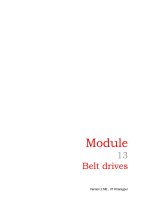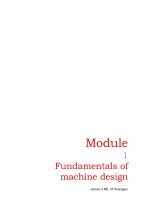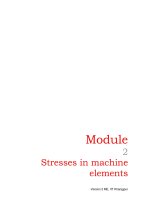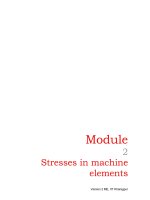Fundamentals of Machine Design P40
Bạn đang xem bản rút gọn của tài liệu. Xem và tải ngay bản đầy đủ của tài liệu tại đây (239.73 KB, 14 trang )
Module
14
Brief overview of
bearings
Version 2 ME , IIT Kharagpur
Lesson
1
Fluid Film bearings
Version 2 ME , IIT Kharagpur
Instructional Objectives:
At the end of this lesson, the students should be able to understand:
Types of bearings
Comparison of bearing friction characteristics
Basics of hydrodynamic theory of lubrication
Design methods for journal bearings
14.1.1 Brief overview of bearings
Bearings are broadly categorized into two types, fluid film and rolling contact
type.
Fluid Film bearings
In fluid film bearing the entire load of the shaft is carried by a thin film of fluid
present between the rotating and non-rotating elements. The types of fluid film
bearings are as follows,
Sliding contact type
Journal bearing
Thrust bearing
Slider bearing
Rolling contact bearings
In rolling contact bearings, the rotating shaft load is carried by a series of balls or
rollers placed between rotating and non-rotating elements. The rolling contact
type bearings are of two types, namely,
Ball bearing
Roller bearing
14.1.2 Comparison of bearing frictions
The Fig. 14.1.1 shows a plot of Friction vs. Shaft speed for three bearings. It is
observed that for the lower shaft speeds the journal bearing have more friction
than roller and ball bearing and ball bearing friction being the lowest. For this
reason, the ball bearings and roller bearings are also called as anti friction
bearings. However, with the increase of shaft speed the friction in the ball and
roller bearing phenomenally increases but the journal bearing friction is relatively
lower than both of them. Hence, it is advantageous to use ball bearing and roller
Version 2 ME , IIT Kharagpur
bearing at low speeds. Journal bearings are mostly suited for high speeds and
high loads.
Shaft speed
Friction
Ball bearing
Roller bearing
Journal bearing
Fig. 14.1.1 Comparison of friction for different bearings
The ball and roller bearings require less axial space but more diametrical space
during installation and low maintenance cost compared to journal bearings. Ball
bearings and roller bearing are relatively costly compared to a journal bearing.
The reliability of journal bearing is more compared to that of ball and roller
bearings.
Here, we will discuss only about journal, ball and roller bearings, being most
commonly used in design.
14.1.3 Journal Bearing
P
P
P
θ
Rest
Low speed
High speed
Fig. 14.1.2 Operation of Journal Bearing
Pressure profile
Version 2 ME , IIT Kharagpur
Fig. 14.1.2 describes the operation of a journal bearing. The black annulus
represents the bush and grey circle represents the shaft placed within an oil film
shown by the shaded region. The shaft, called journal, carries a load P on it. The
journal being smaller in diameter than the bush, it will always rotate with an
eccentricity.
When the journal is at rest, it is seen from the figure that due to bearing load P,
the journal is in contact with the bush at the lower most position and there is no
oil film between the bush and the journal. Now when the journal starts rotating,
then at low speed condition, with the load P acting, it has a tendency to shift to its
sides as shown in the figure. At this equilibrium position, the frictional force will
balance the component of bearing load. In order to achieve the equilibrium, the
journal orients itself with respect to the bush as shown in figure. The angle θ,
shown for low speed condition, is the angle of friction. Normally at this condition
either a metal to metal contact or an almost negligible oil film thickness will
prevail. At the higher speed, the equilibrium position shifts and a continuous oil
film will be created as indicated in the third figure above. This continuous fluid
film has a converging zone, which is shown in the magnified view. It has been
established that due to presence of the converging zone or wedge, the fluid film
is capable of carrying huge load. If a wedge is taken in isolation, the pressure
profile generated due to wedge action will be as shown in the magnified view.
Hence, to build-up a positive pressure in a continuous fluid film, to support a
load, a converging zone is necessary. Moreover, simultaneous presence of the
converging and diverging zones ensures a fluid film continuity and flow of fluid.
The journal bearings operate as per the above stated principle.
The background of hydrodynamic theory of lubrication
Petroff (1883) carried out extensive experimental investigation and showed the
dependence of friction on viscosity of lubricant, load and dimensions of the
journal bearing. Tower (1883 and later) also conducted experimental
investigation on bearing friction and bearing film pressure.
The experimental investigations by Petroff and Tower form the background of the
hydrodynamic theory. Later on Osborne Reynolds conducted experiments and
published the findings in the form of present day hydrodynamic theory of
lubrication and the corresponding mathematical equation is known as Reynolds’
equation.
Version 2 ME , IIT Kharagpur









